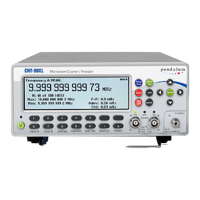Recall the DEFAULT settings.
Connect the LF synthesizer to Input A.
Use the same settings as in the previous
test.
Press INPUT A and select DC and 50
.
Check the first Vmax and Vmin voltage
levels on the display according to the first
row in Table 7-5.
Perform the rest of the settings in se-
quence, an
d read the corresponding Vmax
and Vmin values. Remember that all these
values are approximate and serve only as
indicators of state changes.
Connect the generator to Input B.
Press MEAS FUNC
Freq
Freq(A)
B.
Press INPUT B and select DC and 50 .
Check the first Vmax and Vmin voltage
levels on the display according to the first
Perform the rest of the settings in
sequence, and read the corresponding
V
max and Vmin values.
Acceptance test for oscillators.
X-tal oscillators are affected by a number of
external conditions like ambient temperature
and supply voltage. Aging is also an
important factor. Therefore it is hard to give
limits for the allowed frequency deviation.
The user himself must decide the limits
depending on his application, and recalibrate
the oscillator accordingly.
To check the accuracy of the oscillator you
must have a calibrated reference signal that is
at least five times more stable than the
oscillator that you are testing. See Table 7-6
and the list of test equipment on page 7-2. If
you use a non-10 MHz reference, you can use
the mathematics in the timer/counter to
multiply the reading.
Recall the DEFAULT settings.
Connect the reference to input A
Check the readout against the accuracy
requirements of your application.
Table 7-6 can serve as an acceptance test and
gives a worst case figure after 30 minutes
warm-up time. All deviations that can occur
in a year are added together.
10.00000000 MHz + 0.25 Hz
USER MANUAL ● CNT 9x Series ● Rev.22 February 2020

